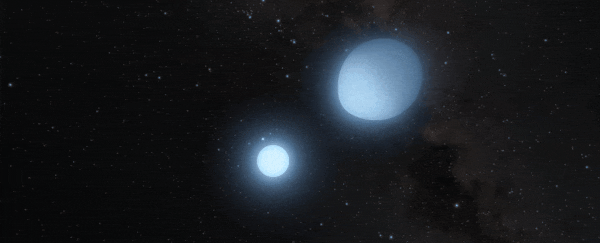Just 7,800 light-years from Earth, two dead stars have been discovered orbiting each other at record-breaking speeds. So close is their orbit, that astronomers expect to detect gravitational waves from this pair in a matter of years, when we turn on more sensitive tools.
We're used to things on cosmic scales happening pretty slowly, but the white dwarf binary - named ZTF J1539+5027, or J1539 for short - has an orbital period of just 6.91 minutes, the shortest ever detected for an eclipsing binary. That's such a close orbit, the entire binary system could fit inside Saturn.
White dwarfs are a type of dead star, the progenitor of which had a mass no greater than about 10 times that of the Sun. If the star is more massive than that, it turns into a neutron star when it dies; make it larger again, and we get a black hole.
It's what we think is going to happen to the Sun. When it runs out of hydrogen to burn, it will inflate into a red giant, fusing helium and carbon until those elements are depleted, too. Then those outer layers will be blown off, and the brightly shining, ultradense core that remains - the dead star's corpse, no longer fusing anything - is the white dwarf.
The two stars in J1539 have already undergone this process. One - the primary star - packs about 60 percent of the mass of the Sun into a core the size of Earth. The other - the secondary star - has much less mass, only about 20 percent of the Sun; but it's also bigger than its companion, so it's less dense.
This lower density and mass also means it's less bright, so when it moves between us and its brighter companion, it completely obscures the latter from view - hence the binary is an 'eclipsing' one. This is how astronomers found it in data captured by Caltech's Zwicky Transient Facility (ZTF) survey at Palomar Observatory.
"As the dimmer star passes in front of the brighter one, it blocks most of the light, resulting in the seven-minute blinking pattern we see in the ZTF data," explained Caltech physicist Kevin Burdge.
That close orbital proximity also means the two stars are already propagating gravitational waves out into space. But we can't detect these waves. Not yet. (We'll get back to that in a moment.)
So far, the only gravitational waves we've detected have been in the last few moments of a collision between more massive objects - neutron stars or black holes. J1539 is relatively lightweight in comparison, and still quite a while from a point where the stars might merge.
But they are growing closer all the time, at a rate of around 26 centimetres per day, which means it's going to be at least another 130,000 years or so until the orbital period is 5 minutes. At that point, mass transfer from the secondary to the primary star will dramatically increase.
From here, it could go two ways. If the mass transfer is stable, the two stars will separate a little, resulting in what is called an AM Canum Venaticorum star, in which the primary star steadily accretes matter from its companion.
If the matter transfer is not stable, the two will probably merge, resulting in a rare type of star called an R Coronae Borealis variable, an erratically pulsating object thought to be the low-mass analog of a type Ia supernova.
That would be amazingly cool, if humans are still around to see it.
So, we may not be around to see the end result of J1539's ever-decaying orbit, and we can't detect its gravitational waves with our current equipment.
However, astronomers believe that the currently-under-development Laser Interferometer Space Antenna (LISA), and other future space-based gravitational wave detectors will change that.
LISA won't be launching until 2034, so there's still time to locate other potential sources of gravitational waves; but for now, J1539 is expected to be the strongest signal in the sky that LISA will be able to detect.
And, in the meantime, the binary can help us understand the dynamics of these extreme systems, and maybe even locate a few others in the vast sky.
The research has been published in Nature.
